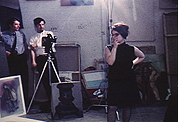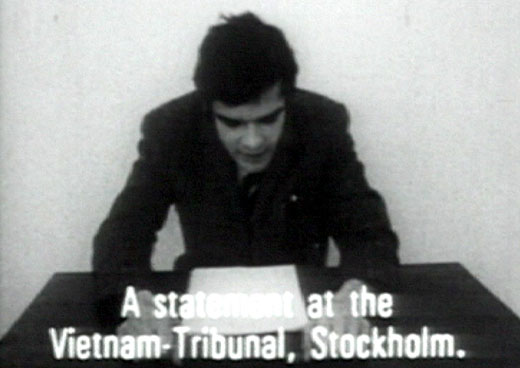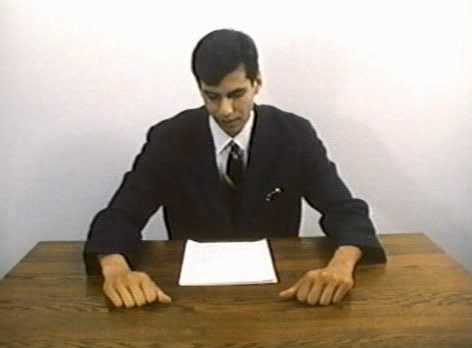An article about “remakes” of independent documentaries, from the November 20, 1998 Chicago Reader. — J.R.
Shulie
Rating *** A must see
Directed by Elisabeth Subrin
With Kim Soss, Larry Steger, Rick Marshall, Eigo Komei, E.W. Ross, Marion Mryczka, Ed Rankus, Kerry Ufelmann, and Jennifer Reeder.
What is it about American culture that compels the film industry to do remakes? The compulsion has been growing over the past two decades — one of my oldest friends, a cinephile and sometime screenwriter based in Hollywood, was already viewing it with philosophical resignation ten years ago. As she put it, “My best friends and I have been spending most of the 80s sitting in cars discussing remakes.”
Since the early 80s we’ve been inundated with more cultural objects than ever before, but we have less and less sense of what to do with them. It’s easy to explain the Hollywood remake syndrome as unimaginative cost accounting: it made money before, so why not do it again? Then there’s the expanding youth market, which encourages unimaginative cost accountants to figure that former hits can be recycled for younger generations — one of the justifications offered by Gus Van Sant for his forthcoming remake of Alfred Hitchcock’s Psycho.
There are, of course, remakes that won’t even own up to being remakes. Introducing his published screenplay for the “new” Lolita, Stephen Schiff insists, “Right from the beginning, it was clear to all of us that this movie was not a ‘remake’ of Stanley Kubrick’s 1962 adaptation….I had not seen it for maybe 15 years, and I didn’t allow myself to go back to it again.” Some of the differences between the two movies are indeed striking, including some that seem designed to provide a contrast; but the action in Schiff’s version — like the action in Kubrick’s and unlike the action in Vladimir Nabokov’s novel — begins at the very end of the story, so it’s hard to believe that Kubrick’s movie played no part in the deliberations.
It’s creepy enough that Hollywood and its flacks — including some uncritical members of the audience — have bought into the inevitability of so many remakes. But when independent and experimental artists start feeling compelled to repeat, my first impulse is to reach for the panic button. After all, the traditional function of the alternative media is to offer alternatives; when they start aping the worst excesses of Hollywood, the implications are not encouraging.
The decision by Elisabeth Subrin and Jill Godmilow, two intelligent and resourceful academics, to remake little-known 60s political documentaries can neither be identified with the Hollywood remake syndrome nor entirely disentangled from it. It seems to me that they and Hollywood are responding to the same cultural and political block — an inability to come up with new thoughts about the present — but I don’t believe they’re responding in the same way or for the same reasons. After all, it isn’t as if they’re remaking classics of the avant-garde like Un chien andalou, Meshes of the Afternoon, or Scorpio Rising. On the contrary, they’re calling attention to buried works most of us wouldn’t have a clue about if it weren’t for their films.
It’s worth adding that the impulse to copy classic works has been a staple of the avant-garde for some time; Yvonne Rainer’s formidable first feature, Lives of Performers (showing at the Film Center on Friday), concludes with a restaging of stills from the published script of G.W. Pabst’s silent film Pandora’s Box, one of the most important Louise Brooks features. And it was amusing to discover from Subrin that the flacks promoting the remake of Psycho contacted her about her remake because they feared Gus Van Sant might not be doing something entirely original in remaking a film shot by shot. In fact, the practice has existed for most of this century, though one wouldn’t expect contemporary publicists to be aware of such precedents. (One famous early example is John Cromwell’s 1938 Algiers, a Hollywood remake of Julien Duvivier’s 1936 French feature Pepe le Moko, but I’ve heard that some Edwin S. Porter films were remade in the same fashion during the first years of this century.)
Godmilow’s What Farocki Taught [see second photo above], a half-hour remake of Harun Farocki’s German agitprop film Inextinguishable Fire (1969) [see first photo above], recently turned up at the Film Center, and Subrin’s Shulie [see second photo in heading], a half-hour remake of a 1967 Chicago documentary of the same title [see first photo in heading] by four Northwestern students — Jerome Blumenthal (today known as Jerry), Sheppard Ferguson, James Leahy, and Allan Rettig — is being shown this Friday at the same venue (on a separate program after Rainer’s film; Subrin and Blumenthal will attend the screening). The differences between these two works are as important as the similarities, but the main thing they seem to have in common is a political impulse to return to the 60s as a way of figuring out how to deal with the present.
The subject of Inextinguishable Fire and What Farocki Taught is the manufacture of napalm during the Vietnam war. Farocki stages a series of events and dialogues with actors to illustrate didactically his various points; Godmilow translates the dialogue from German to English and shoots in color instead of black and white, but otherwise adheres closely to the original.
The subject of both versions of Shulie is 22-year-old Shulamith Firestone, who in 1967 was getting a BFA with a major in drawing and painting at the School of the Art Institute, making photographs, and supporting herself by working at the post office. Three years later she would publish The Dialectic of Sex: The Case for Feminist Revolution, a powerful and highly influential book (I read it in the early 70s) that’s seldom mentioned today, though it was reprinted five years ago. In Subrin’s version, Firestone is played by Kim Soss, who worked on the film in other capacities too, and Firestone’s teachers and a couple of her friends are played by other actors.
At the Rotterdam film festival this year I saw both Godmilow’s film and Subrin’s video. At that time Shulie concluded with the disclaimer “This is a work of fiction,” which has since been removed. There’s no question that remaking a fiction film like Farocki’s — even if the fiction has a didactic, documentary function — is radically different from remaking a documentary like the 1967 Shulie. I think it could even be argued that Godmilow’s work turns a fiction film into a documentary and Subrin’s work turns a documentary into a fictional video. Both works attempt in their different fashions to collapse the 60s into the 90s and vice versa, and in this endeavor Shulie may fail more profoundly simply because there’s a world of difference between a 22-year-old woman speaking for and about herself and an actress speaking the 22-year-old’s words. It’s not a commentary on Soss’s skill as an actress that her manner of speaking is colorless and more guarded than Firestone’s and that she conveys a certain emotional vacancy. But it’s difficult to pinpoint how much this is a matter of the differences in everyday speech and body language now and 30 years ago and how much this is a matter of existential authenticity. Subrin’s uncanny precision in fanatically duplicating some of the awkward camera angles and ragged cuts of the original ultimately reinforces our sense that the past can only be imitated. (Subrin describes Soss’s performance as an “interpretation” rather than an attempt at duplication, but this in no way prevents Soss’s behavioral tics from reeking of the 90s.)
This ambiguity is one of the abiding mysteries of Subrin’s project, and it makes her video much denser than Godmilow’s film as a historical inquiry, even though Subrin is about 20 years younger than Godmilow and didn’t experience the 60s as an adult. It’s a mystery that — not as an act of will but inadvertently — forces the 90s to the surface much more profoundly than Godmilow’s more controlled experiment possibly could. Godmilow is interested in teaching the 90s how to think as well as speak, but Subrin is bent on discovering what the 90s are already thinking and saying. Though it was her discovery of the 1967 Shulie that led Subrin to read The Dialectic of Sex, it’s clear that she finds the only partially articulated feminist issues of the original film relevant, even contemporary.
Godmilow remade a 60s agitprop work for more theoretical reasons; she offers Farocki’s film as a political model, but at a time when napalm and the Vietnam war are no longer contemporary issues. It may be possible to extrapolate from Farocki’s analysis and use his methods to uncover outrages today that are being perpetrated in our name and with our tacit consent, but Godmilow takes us only a small part of that distance. She appears to be working from the premise that the mid-90s represent a political ground zero and that we need to go back 30 years to understand this.
Subrin’s model, if I read her intentions correctly, is not so much the 1967 film Shulie as it is Firestone herself — what she was in 1967 and what she was shortly to become, which the original film semi-inadvertently pays witness to. It’s important to stress that the 1967 Shulie was made by four men and that the five teachers in the film who interrogate Firestone about her paintings are also all men; considering that it was 1967, it isn’t surprising that the discourse of everyone — with the partial exception of Firestone, who offers some faltering and at times apologetic resistance to her male questioners — is resolutely prefeminist. (One comes away from both films with a sense that nine men ganged up on Firestone, which is also highly characteristic of the mid-60s.) In the remake, it’s Subrin rather than a male filmmaker (Blumenthal) who asks “Shulie” the offscreen questions, and though the questions being asked are the same, they register in a decidedly different way.
It’s important to note that Firestone herself objects to both versions of Shulie, though she hasn’t spoken publicly about what her objections are. (Perhaps her problem is the same as mine: reconciling the tentativeness of her 1967 persona with the rage and precision of The Dialectic of Sex.) Subrin’s video does raise the ethical issue of what it means to duplicate someone’s impromptu remarks — not to mention her everyday life and even her canvases and drawings (which have been copied with loving exactitude). One also has to take into account the fact that Firestone’s mid-60s discourse was controlled to some extent by the four male filmmakers’ filming and editing choices. Subrin’s decision to treat this material as “found” object and historical artifact also sets it somewhere beyond the will of the ostensible subject — which isn’t changed by bracketing the material with statements about the importance of The Dialectic of Sex.
I have to confess that I prefer Subrin’s Shulie to the film it remakes, if only because the complex historical pathos produced by her efforts yields far more information about the 90s than the original film could possibly tell us about the 60s, then or now. However, I prefer Inextinguishable Fire to What Farocki Taught, because the political motivations of the former are more direct and lucid. My preferences have very little to do with the technical skill or resourcefulness of either Subrin or Godmilow, but they have a great deal to do with assessing the value of a political work in its own time.
Godmilow’s film, like Farocki’s, is shot almost exclusively in interiors, which gives her more opportunity to create precise equivalents of the shots in the original. Subrin’s video, like the original Shulie, consists largely of documentary shots filmed in the streets and neighborhoods of Chicago, which obliges her at times to use only approximations. Both versions of Shulie, for example, show the subject walking with a friend into a movie theater playing Andy Warhol’s 1966 The Chelsea Girls. Not being a longtime Chicagoan, I didn’t recognize the theater in the original, though it appears to be a large movie house in the Loop; in the remake it’s the Music Box. (Her opening montage of Chicago locations has no counterpart in the original.)
With some justice, conventional wisdom has it that the 60s were a much freer time than today, so there’s a certain boldness in Subrin focusing on a moment in that period when feminist consciousness was still struggling to be defined. The paradox is that even historical hindsight isn’t enough to give an actress playing Firestone 30 years later the kind of emotional urgency Firestone conveyed in the original film through her own shyness and confusion; Soss [see both photos below] projects the kind of contemporary coolness we tend to identify as normal. Yet it’s only through this juxtaposition that we begin to see the petrifying fear that describes our present moment — the kind of fear that makes the very notion of a remake seem like a logical response.
William Faulkner once remarked that he arrived at his prose style as a novelist only by first failing as a poet and then by failing as a short story writer; one might hypothesize that his achievement as a novelist is therefore inextricably tied to his failed attempts to imitate Keats and Wordsworth. In a comparable spirit, Dizzy Gillespie once described the origins of his own style in his unsuccessful efforts to play like Roy Eldridge. I think it can be argued that Godmilow’s successful attempt to duplicate Inextinguishable Fire offers a provocative starting point for a discussion about the political void of the 90s, but not much more. Whereas Subrin’s less successful attempt to duplicate a much less interesting film tells us more about the 90s than we can begin to make use of.








